|
A closer examination
of Duchampís 1964 urinal etching shows that, although Duchamp did base
his tracings on the Stieglitz photograph to create this etched image,
he, also and importantly, added a separate and specific extra part --
in a yet another perspective view, more radically different from the
rest. Note, when comparing illustration 46A, B and C with 47A and 47B,
the extreme leftward position that the whole urinal would have to occupy
(47B) for us to see this one urinal part in the upper right side (47A).
Why else would Duchamp move so far away from traditional perspective
in one exaggerated and isolated part of this drawing, if not from a
desire to push his point further, probably because we are likely not
yet again to notice his new rehabilitated perspective system based upon
fusions of multiple points of view in his drawings, models or photographs.
Remember this etching was done at the end of his life, in 1964. Duchamp
had already exposed his new perspective system to the world since his
1912 Chocolate Grinder painting and no one noticed. Moreover
we continue to not notice because the mind creates and depends on such
composites of information that Duchamp was presenting as perspective
all the time.
|
click
each image to enlarge
|
|
|
|
|
|
Illustration
46A.
|
Illustration
46B.
|
Illustration
46C.
|
|
Stieglitz
version of Duchamp's Fountain urinal
|
Etching,Marcel
Duchamp, An Original Revolutionary Faucet: Mirrorical Return,
1964 © 2000 Succession Marcel Duchamp, ARS, N.Y./ADAGP, Paris
|
An
overlay of Duchampís etching (1964) when flopped , and placed
onto the Stieglitzís photograph of Duchampís Fountain (1917)
indicates that used a tracing method.
|
|
|
click
left image to enlarge; click right image for animations
|
|
Click
to see a video of our animation analysis, comparing the 3D model
made from the idealized Stieglitz urinal (without
the distortions in the original photo) that Duchamp
draws with the varied positions that it would have to occupy to
match the multiple perspective descriptions contained within the
etching.
|
|
|
|
Illustration
47A.
|
Illustration
47B.
|
|
Video of
Urinal animation analysis based on the 1964 etching.
Note: Extra perspective part Duchamp added to Stieglitz urinal
image for his Etching, as well as how far turned to the left,
the urinal would have to be turned to see the perspective view
of this added part.
(Animation created by Gregory
Alvarez and Rhonda Roland Shearer.)
|
Given Duchamp's claim
that he studied the entire section on perspective at the Parisís main
library, and that, it is a "no-brainer" to trace the basic
shape of the Stieglitz urinal without mistakes, it would be difficult
to believe that this extra and distinct perspective part added by Duchamp
to his urinal etching, would have occurred through accident or incompetence.
We are especially encouraged to conceive of Duchamp's extra perspective
piece as intentional, since the rest of the etching captures the spatial
relations of the Stieglitz photo so well, including the pipe hole offset
to the left, and so forth.
I must add one final
point to buttress my case about the urinal. In the quotation on perspective
that I cited at the beginning of this essay, Duchamp claimed that he
added language, in addition to anecdote, in his rehabilitated form of
perspective. Bonnie Garner suggested that when Duchamp signed his urinal
Mutt, he, in effect, communicated linguistically the same structure
that he used geometrically (with his fusing of multiple perspective
parts into one whole). For what else is a "mutt" than an entire
mongrel dog composited of many dog breeds (or parts) put together in
time -- an entity that only appears to be, in a traditional perspective,
a low quality whole.
|
click
to enlarge
|
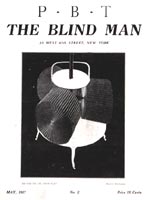 |
|
Illustration
48.
|
|
Cover of
The Blind Man, No. 2: P.B.T., 1917.
Just as Duchamp did with the Urinal, Duchamp combined the Chocolate
Grinder with the title of the journal, The Blind Man.
|
The other colloquial
definition of mutt as "a stupid person" brings me back
to thoughts about the first appearance of Duchampís urinal in The
Blind Man (1917). Not only was the Mutt urinal essay and image placed
under The Blind Man heading, but Duchamp and his close friends
also(and, I believe, not coincidentally) used Duchampís Chocolate
Grinder painting on the front cover, under The Blind Man
banner, as well -- see illustration 48.
I argue that this
placement of the Chocolate Grinder painting with the Blind
Man heading relates directly, in meaning, to Duchampís similar positioning
of his urinal. For as spectators in 1917, we would have been specifically
blind to Duchampís new rehabilitated perspective used in both
his Fountain urinal and Chocolate Grinder forms,
as well as generally blind, as a consequence our foolish dependence
(as Duchamp believed) on conventional perspective and "retinal
vision" for determining factual reality.
My discovery
that the strangely distorted Chocolate Grinder uses the same systematic
characteristic approach also found in the hatrack, coatrack and urinal
(and a large set of other examples not discussed in this essay) returns
us to Duchampís words that I used at the beginning of this essay --
a quotation that now bears repeating.
| Duchamp: |
Perspective
was very important. The "Large Glass" constitutes a rehabilitation
of perspective, which had then been completely ignored and disparaged.
For me, perspective became absolutely scientific. |
| Cabanne: |
It was no longer realistic perspective. |
| Duchamp: |
No.
Itís a mathematical, scientific perspective. |
| Cabanne: |
Was
it based on calculations? |
| Duchamp: |
Yes,
and on dimensions. These were the important elements. What I put
inside was what, will you tell me? I was mixing story, anecdote
(in the good sense of the word, with visual representation, while
giving less importance to visuality, to the visual element, than
one generally gives in painting. Already I didn't want to be preoccupied
with visual language. . . . |
| Cabanne: |
Retinal. |
| Duchamp: |
Consequently,
retinal. Everything was becoming conceptual, that is, it depended
on things other than the retina. |
Duchampís claims in
this interview (albeit cryptically) that he has done something rigorous
and different to rehabilitate perspective, and that he has embodied
this novelty in his new geometry in the Large Glass -- with the
Chocolate Grinder as one part!
In 1956 Duchamp stated
"I was already beginning to make a definite plan, a blueprint for
the Large Glass. All of this was conceived, drawn, and on paper
in 1913-14. It was based on a perspective view, meaning a complete knowledge
of the arrangement of the parts. It couldnít be haphazardly done or
changed afterwards. It had to go through according to plan, so to speak."
In the Cabanne interview Duchamp further claims that "I had worked
eight years on this thing, (the Large Glass) which was willed,
voluntarily established according to exact plan. . ."
Duchamp carefully
provided us with his "Sears Roebuck-like" catalogue of notes
and drawings describing his Large Glass project. Mostly written
between 1911-15, these notes include a separate plan view and a side
elevation of the lower "bachelor half" of the Large Glass,
(but no 3-D model) and a perspective drawing illustrating measurements
at 1/10 scale of the final Large Glass work, see illustration
49A, B, C,D.
|
click
each image to enlarge
|
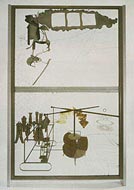 |
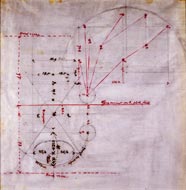 |
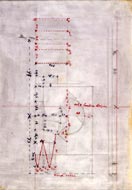 |
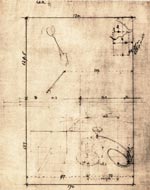 |
|
Illustration
49A.
|
Illustration
49B.
|
Illustration
49C.
|
Illustration
49D.
|
|
Perspective
view,
The Bride Stripped Bare by Her Bachelors, Even,
1915-23
©
2000 Succession Marcel Duchamp, ARS, N.Y./ADAGP, Paris
|
Plan section of Bachelor Apparatus: Facsimiles of Plan and
Elevation, 1913/1934 © 2000 Succession Marcel Duchamp,
ARS, N.Y./ADAGP, Paris
|
Elevation
section of Bachelor Apparatus: Facsimiles of Plan and Elevation,1913/1934
© 2000 Succession Marcel Duchamp, ARS, N.Y./ADAGP, Paris
|
Perspective
drawing, The Bride Stripped Bare by Her Bachelors, Even,
1913 © 2000 Succession Marcel Duchamp, ARS, N.Y./ADAGP, Paris
|
Architects or engineers
depend upon similar plan views and side elevations as Duchampís Bachelor
half to manufacture 3-D projects and small scale 3-D models. As discussed
earlier, perspective drawings, in contrast, indicate the relative position
of a particular observer in visual relation to the object or building.
A "precise and exact aspect" in the science of perspective
(an "aspect" that Duchamp said he was interested in following),
dictates that the perspective in the lower half of the Large Glass
drawing should relate to the geometry of the "blueprint" plan
and elevation. In other words, if you make a 3-D model following Duchampís
plan view and side elevation blueprints, you should readily be able
to find and replicate the perspective view that Duchamp depicts in his
perspective drawing by using this very same 3-D model.
Most Duchamp scholars
have either accepted or praised Duchampís perspective skills. The problem
remains, however, that I and a few other scholars have actually made
3-D models from Duchamp's plans -- and none of us can find any one
perspective projection view that matches Duchampís perspective drawings!
Moreover, the process of trying to recreate the Large Glass perspective
drawing from what a viewer would see of the 3-D model via perspective
(equivalent to what one eye or camera lens sees) quickly becomes maddening.
When you fit one part of the Large Glass model to its projection
in Duchampís perspective drawing (say; part A, the ellipse in one wheel
of the Chocolate Grinder, for example -- see illustration 49A),
the rest (parts B through Z) immediately fall out of place. We lose
the fit of part A, and all the other parts C through Z, once part B
is matched -- etc.
We may then be tempted
to somehow change the plans so that the perspective projection, as laid
out in Duchampís actual Large Glass, can be generated from the
3-D model (built from the plan and elevation view) -- which is, in fact,
what some scholars have done. But thatís cheating, and such a providence
also assumes that Duchamp was incompetent, or did not care about accuracy
of perspective, although he claimed otherwise in earlier interviews,
as well as to Cabanne.
If both the plan view
and side elevation construct a consistent 3-D model of the Chocolate
Grinder and the overall Large Glass itself, how and why have
I and other scholars failed to generate a similar, if not exact, perspective
drawing from this 3-D Large Glass model? I will argue that the
reason why we cannot generate a single perspective view (in duplicating,
what should has been the process that Duchamp followed to create his
perspective drawing) must be Duchamp himself did not used perspective
geometry, but, rather his new rehabilitated perspective -- the method
that created his perspective drawing and the Large Glass (a.k.a.
The Bride Stripped Bare by Her Bachelors, Even 1915-23.)
|
click
each image to enlarge
|
|
|
|
|
Illustration
50A.
|
Illustration
50B.
|
|
Cube
seen in 2D parts
as eye moves around it
|
Perspective
distortions
of cube in relation to fixed eye
|
If we analyze the
parts of the Large Glass (a 2D perspective view), using a 3D
model constructed from Duchampís plans, we can only duplicate the depictions
in what is rendered in Duchampís Large Glass 2D perspective drawing
when we move our eye in time around the Large Glass 3D model
to collect snapshots (cuts), and then fuse these separate perspective
parts together into one depiction -- the very same method that Duchamp
uses in his coatrack, hatrack and urinal 2D representations. Recall
the illustrations (now #50A,B) showing the different perspective depictions
resulting from 4 different fixed eye positions, in contrast to an eye
that moves around a cube.
Illustration 51A,
B, C present three animations from our analysis of Duchampís Chocolate
Grinder and Large Glass in 2D and 3D. The first animation
(51A) shows the cameraís perspective while moving around a 3D model
of the Chocolate Grinder in 3D space. Colors highlight the part
that corresponds to the equivalent section of the 2D Chocolate Grinder
in the Large Glass perspective drawing. In other words, the animation
shows a position that both the camera and 3D Chocolate Grinder
would have to occupy to create the particular 2D Chocolate Grinder
part shown in color code.
|
click
each image and see animations
|
|
|
|
|
|
Illustration
51A.
|
Illustration
51B.
|
Illustration
51C.
|
|
Three
animations from our analysis of Duchampís Chocolate Grinder
and Large Glass in 2D and 3D
(created by Gregory
Alvarez and Rhonda Roland Shearer)
|
The next animation,
51B, shows our 3D computer model of the Chocolate Grinder as
fundamentally based upon Duchampís 1913/1934 plan view and side elevation
plans. The animation further depicts how the position of the camera
determines the particular set of distortions seen by the lens in any
one 2D snapshot of the 3D Chocolate Grinder. Moreover, this animation
depicts that once one camera position allows a match in one part of
the Chocolate Grinder, the other parts of the Chocolate Grinder
and the Large Glass depart from this single perspective position.
When other Chocolate Grinder parts are matched, each exists in
its own perspective framework. Our efforts to tame all Chocolate
Grinder parts into one perspective view, slips hopelessly away with
each successful match of a single part, and the consequent complete
rejection of the rest in lock step.
|
click
to enlarge
|
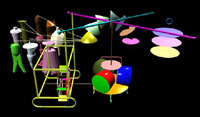 |
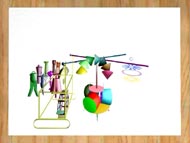 |
|
|
Illustration
51D.
3D
model
|
Illustration
51E.
2D
composite
|
|
|
Due
to perspective constraints, we would have to move one eye or lens
in 3D space and time approximated 43 times around the 3D model
to actually see the same information as Duchamp shows us in his
Large Glass work in only one instant.(Created by Gregory
Alvarez and Rhonda Roland Shearer
|
|
The next animation
sequence, 51C, illustrates the cut and paste method that Duchamp probably
used to create not only his Chocolate Grinder (and also his coatrack,
urinal, hatrack, etc.), but the entire bottom half of the Large Glass
itself. As any one photograph yields a single perspective view (with
its own particular distortions), Duchampís selection of one part from
each snapshot, after he pastes them together, creates a multiple fusion
of varying perspectives. The last frame, showing the Large Glass
in color coding, indicates each of the (approximately) 43 parts that
live in their own perspective world, see Illustrations 51D and 51E.
Due to perspective
constraints, we would have to move one eye or lens 43 times in 3D space
to actually see the same information that Duchamp shows us in his single
Large Glass work! Illustrations
51F and 51G map the 43 camera positions in relation to the Large
Glass 3D model that produced the 2D color coded projections in 51D
and 51E.
|
click
to enlarge
|
|
|
|
|
Illustration
51F.
|
Illustration
51G.
|
|
Side
view of set of 43 possible camera positions Duchamp used to create
his Large Glass fusing approx 43 photo parts cut from photographs
in 43 different perspectives.
|
Top
down view of set of 43 possible camera positions Duchamp used
to create his Large Glass fusing approx 43 photo parts
cut from photographs in 43 different perspectives.
|
|